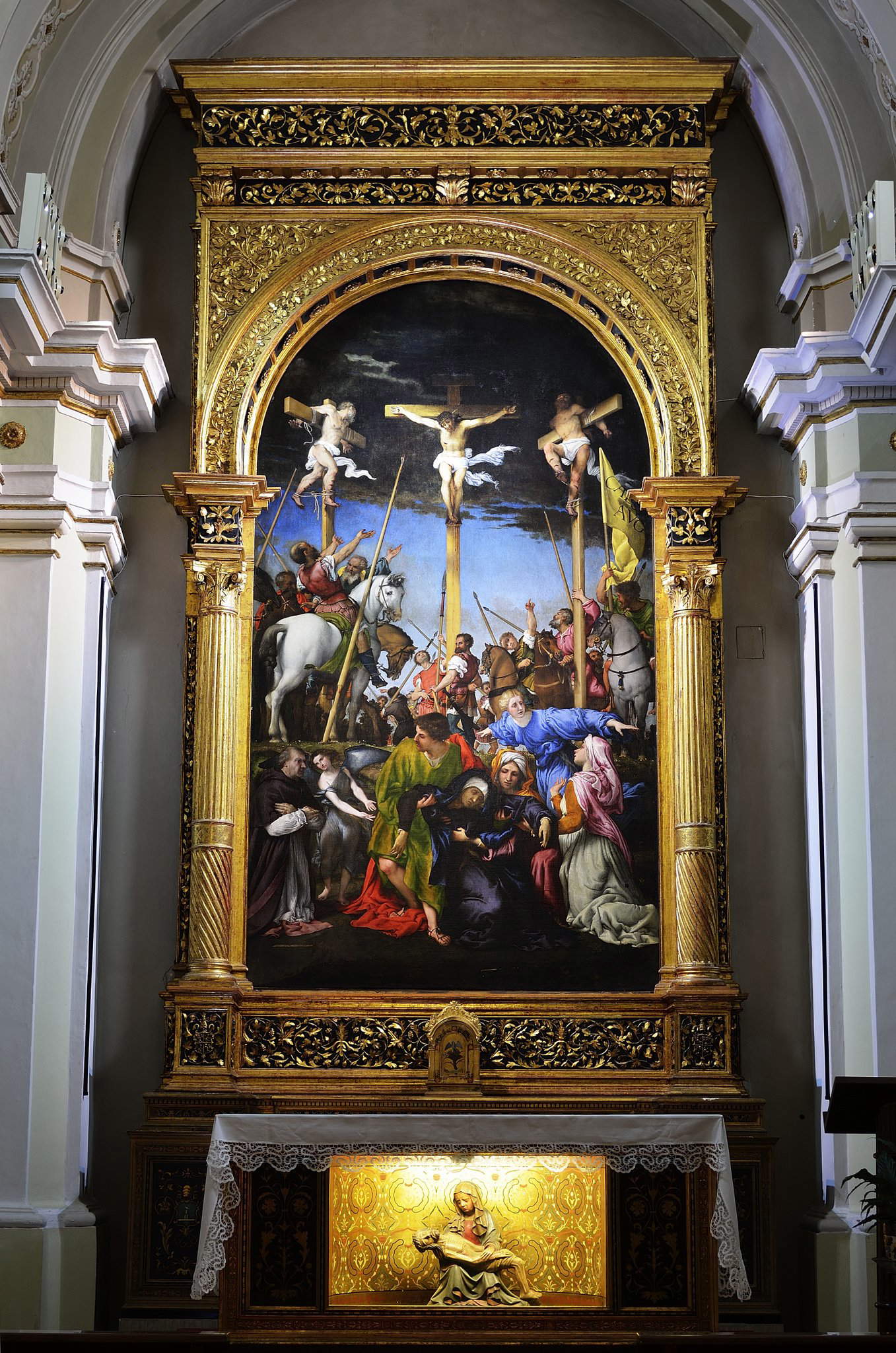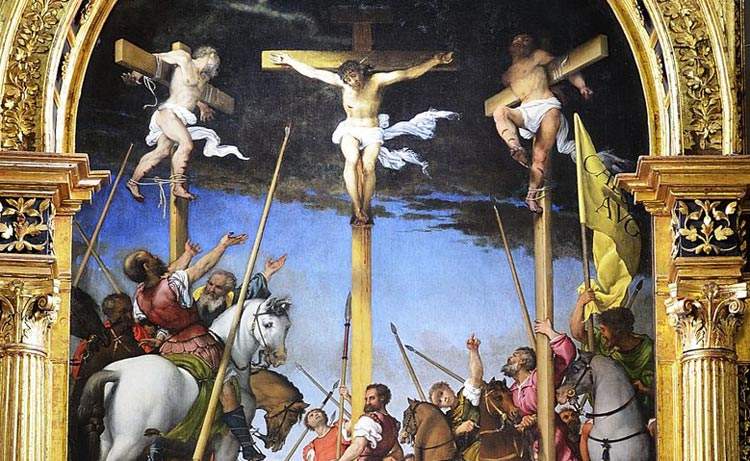A video to learn about Lorenzo Lotto's extraordinary Crucifixion in Monte San Giusto
A video to learn in detail about one of Lorenzo Lotto ’s (Venice, 1480 - Loreto, 1556/557) masterpieces, the Crucifixion preserved at Monte San Giusto in the church of Santa Maria della Pietà. Commissioned by Bishop Niccolò Bonafede, the work was painted in Venice around 1528-1529, at one of the most important passages in Lotto’s life, and is one of the most important works of the 16th century. The video (available from today, in Italian and English, on the channels of the Municipality of Monte San Giusto) is the brainchild of Enrico Maria Dal Pozzolo, curator of the major exhibition on Lotto held in the Marche region in 2018.
On July 16, 2018, Enrico Maria Dal Pozzolo, of the University of Verona, together with Matthias Wivel, of the National Gallery in London, went to Monte San Giusto to see the Crucifixion preserved in the small church of Santa Maria della Pietà, and the vision of that painting (which strongly impressed Wivel, who saw it for the first time in person) gives rise to the idea of dedicating two films to the work, which the Municipality of Monte San Giusto has had made, on texts and with readings by Dal Pozzolo (for the Italian audience) and by Wivel (in English, for the international audience), online from April 6, 2021. They were packaged by young videomaker Gionata Cantolacqua, based on the directions of the two authors. The work tries to make the general public understand what treasure is preserved in the small town in the province of Macerata: with a simple but rigorous reading, it explains its genesis and uniqueness. And in the intentions of the municipality, it aims to be the easiest way to get to know, in five minutes, one of the most extraordinary masterpieces of the European Renaissance, and perhaps to plan a visit in person to this place where, as Antonio Paolucci wrote, “the painting is bigger than the church.”
 |
| Lorenzo Lotto, Crucifixion (1528-1529; oil on canvas, 425.5 x 248 cm; Monte San Giusto, Santa Maria della Pietà) |
“This product,” Dal Pozzolo recalled at the press conference, "was born at the very moment when the Lorenzo Lotto exhibition was being worked on in a fairly initiated way. The Lure of the Marches, which had as its pivot Palazzo Buonaccorsi in Macerata, but which was actually built as a diptych, thus leaving the works of the territory in the territory. In order to better follow the installation work, but also to review the works we were supposed to write about, with my family (my wife Francesca, my daughter Lavinia and our little dog Sissi) we moved through this territory so beautiful and so little known compared to other areas of Italy, and we had the pleasure of being able to do so with Matthias Wivel, curator at the National Gallery in London, with whom we had just collaborated for the exhibition on Lorenzo Lotto’s portraits that had the Prado as its first venue and the National Gallery in London as its second venue. Matthias came for a few days specifically to have the opportunity to see live works that otherwise would never have been convened within the exhibition. One day we happened to be in Monte San Giusto-I had gone there for the first time at the time of my dissertation, and every time is always a thrill, a surprise. And when we entered this small church, we were silent for a while. I also probed Matthias’ reactions: we had been to several wrestling places, but perhaps never as in this situation did I catch his great astonishment. In that circumstance we understood that, beyond a dimension of possibility that is obviously proportionate to the number of inhabitants, there was a great awareness of the fact that we held a creation that has no particular comparison in Italian and European art of the period, and we remained on good terms with the municipality. When, during the first lockdown, we were all locked in the house, we had the idea of writing a piece for a film, involving Matthias Wivel as well. We then recorded a text that would match what we were commenting on, firing off two separate but somewhat related commentaries, differentiated by the fact that I speak in Italian and try to frame the Venetian origin and the context, including the psychological context of the execution of this work, while Matthias goes into more detail in the reading of the painting, and so we had the opportunity to propose to the Municipality of Monte San Giusto a film aimed at Italian fans and a different one that could also entice international tourism to venture into this magnificent region that is also so rich in humanity."
“What is really impressive about Lotto’s Crucifixion,” said Matthias Wivel, “is that this painting represents an epic work, but very rich in detail. And my goal in writing the text for the video was to capture the most salient details precisely to get a full understanding of the genius that was Lorenzo Lotto. What I noticed about the structure is the lengths, the diagonals that form a dynamic structure of the painting with the two thieves, and what I noticed in the church is that Longinus, when he points toward Christ, also has blood running down his hand, and this is a detail that has psychological meaning, obviously also religious meaning, but this is expressing his originality that is also natural and real. If you look at it well, it is a very complex masterpiece, which causes great emotional amazement: I was particularly amazed by Lorenzo Lotto’s mood, which is always present. Moreover, this painting in Monte San Giusto, besides being a work of Venetian art, also contributed to the development of the Venetian style.”
The work, recalled Mauro Spinelli, councillor for Budget, Culture and Tourism of the Municipality of Monte San Giusto, can be seen in the church of Santa Maria della Pietà even during Covid period: in fact, the churches remain open. The alderman also let it be known that as soon as the government restrictions on museums are removed, the Museums of Monte San Giusto will also reopen, which are already ready to restart. Some sites are still closed due to inaccessibility after the 2016 earthquake, but the church and the Museums of Monte San Giusto can be visited (the museums as soon as possible). “The church of Santa Maria,” Spinelli recalled, “after a small intervention was immediately reopened within a year after the earthquake and is usable every day: the church, for us, is an important point of attraction, allowing us to bring people and tourists also to visit the Museum of Palazzo Bonafede, which is located in the basement of the palace, where there is a very important collection of ancient drawings, the Alessandro Maggiori collection, and some paintings that have been restored recently and were inside one of our city churches. The museums have always remained open, except unfortunately during the red zone phases, when we had to keep them closed: we have taken the opportunity to update or to fix some of the arrangements, as we are doing now with the exhibition and the Mggiori breakfast where we have replaced some of the display cases with newer products and norm, and we will also soon change all the lighting with new LED light fixtures, so during the closed period we have taken the opportunity to make some small investments in the conservation of the works. However, the museum facilities are both available for when people return to be able to visit them.”
 |
| A video to learn about Lorenzo Lotto's extraordinary Crucifixion in Monte San Giusto |
Warning: the translation into English of the original Italian article was created using automatic tools. We undertake to review all articles, but we do not guarantee the total absence of inaccuracies in the translation due to the program. You can find the original by clicking on the ITA button. If you find any mistake,please contact us.



























